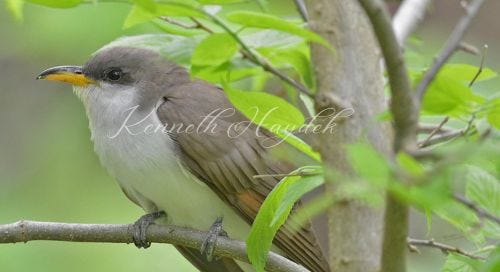June: The Yellow-Billed Cuckoo
While they may not be meteorologists per se, these birds have an interesting reputation connected to the weather: meet the yellow-billed cuckoo.
In late spring and throughout the summer months, the yellow-billed cuckoo dwells among dense cover of deciduous trees, often along streams and rivers, east of the Mississippi River. (Sadly, in the western U.S., these birds are on decline due to habitat endangerment.) In the fall and winter, they migrate over land to South America and have been spotted as far as Argentina.
Yellow-billed cuckoos select their habitats based on food choices, most especially, the availability of caterpillars. They are one of the few bird species to feast on the hairy caterpillar and will be drawn to areas where tent caterpillars are plentiful. Yellow-billed cuckoos have been known to eat as many as 100 caterpillars in one sitting. They will also eat moths, crickets, beetles, katydids, and cicadas. Like many birds who eat insects, their diets incorporate more seeds and fruit in the fall and winter.
Because they most often live among heavily leafy areas, yellow-billed cuckoos can be hard to spot. How will you know one if you see it? As the name suggests, yellow-billed cuckoos have yellow bills, which are topped with grayish black. The bills curve downward and are nearly as long as their flat heads. Yellow-billed cuckoos are medium-sized birds, somewhere between the size of a robin and a crow. They have a grayish face, yellow eye rings, brown heads and bodies, with white necks and underbellies. Their inner wings are rust-colored, and their long tails are black with white bands that look similar to large polka dots.
Male and female yellow-billed cuckoos build their nests together and take turns incubating and brooding their young. Females do not lay their full brood (1 – 5 eggs) all at once. These birds may space out the laying of eggs as much as five days apart. Thanks to this “asynchronous” method of laying eggs, and an incubation time of 9 – 11 days, one chick may be just about ready to leave the nest when another one is hatching.
Yellow-billed cuckoos may lay eggs in other birds’ nests—other cuckoos as well as birds like robins and thrushes—especially in seasons when insects are plentiful. It will be interesting to see, with the emergence of both the 13- and 17-year cicadas this year, if birders observe a greater prevalence of “nest borrowing” among yellow-billed cuckoos this year.
What about the weather? Yellow-billed cuckoos are recognized by their croaky-sounding call, which can be heard at quite a distance. Folklore says that yellow-billed cuckoos make their call on hot, humid summer afternoons to invite the rain or to herald its coming or as a “call-and-response” to thunder. These stories have earned them the nickname “rain crow.” So, when summer storms crop up, listen attentively to that low rumble in the distance—it may just be a yellow-billed cuckoo making a meteorological broadcast.
Sources:
https://www.allaboutbirds.org/guide/Yellow-billed_Cuckoo/overview
https://www.audubon.org/field-guide/bird/yellow-billed-cuckoo
https://abcbirds.org/bird/yellow-billed-cuckoo/
https://nkytribune.com/2019/08/art-landers-outdoors-the-distinctive-call-of-the-yellow-billed-cuckoo-foretells-of-summer-storms/



